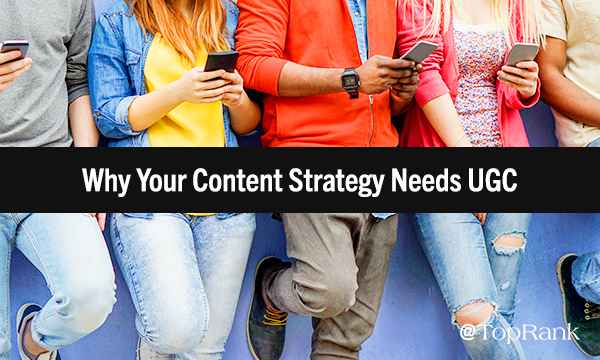Why Content Marketers Everywhere Need to Get Down with User-Generated Content

UGC: An Avenue to Authentic Awareness and Trust
Even the most well crafted and relatable content is inevitably viewed through a certain lens when it comes from a brand. Developing a genuine rapport with your audience takes time, and even then, there’s an inherent recognition that any public-facing message from a company is strategic and carefully positioned. User-generated content offers a method to overcome this disconnect, by amplifying the voices of real people and actual customers. If your content marketing goal is authenticity, there’s no better bet. [bctt tweet="#UGC offers a method to overcome disconnect, by amplifying the voices of real people and actual customers. - @NickNelsonMN #ContentMarketing" username="toprank"] One interesting section of the aforementioned Edelman report features data around the content people trust most:Benefits of User-Generated Content
#1: Making the Customer Your Story
Storytelling is one of the most essential tactics in content marketing, and customer-centricity is among the discipline’s central tenets. UGC presents a way to merge these two by actually making turning your customer into the storyteller. Not only is this an extremely engaging role for the individual whose content is featured, but it makes that content vastly more relatable for those consuming it. When TINT polled marketing professionals for its 2018 User-Generated Content Marketing Report, the most-cited advantage of UGC was its ability to “humanize marketing,” with 73% agreeing this form of content “makes marketing more authentic.”#2: Building a Community and Boosting Engagement
Once others start noticing the presence of user-generated content on your website, blog or social media feeds, it can cause a contagious effect. In general, people like to participate in trendy or connective ventures, especially if there is a compelling and creative hook (Ice Bucket Challenge, anyone?). For example, social media management platform Buffer introduced the #BufferCommunity hashtag on Instagram and receives regular submissions from all around the world. The content – which is frequently regrammed on the company’s official account, with credit – isn’t promotional, but it’s not supposed to be. It brings the product’s users together and raises general awareness for the brand. Organic content in action is a beautiful thing (literally, in this case):#3: Implementing Visuals
As we often preach here at TopRank Marketing, visuals are essential to content marketing but often difficult to produce with limited resources. UGC is primarily visual in nature so it represents an easy way to strengthen this dimension of your content mix. Plus, when regular people see other regular people in photos or videos, rather than models or actors, it adds to that relatable authenticity factor. Via Travis Wright at Marketing Land:Currently, photos and videos are the most popular forms of UGC. Fifty-four percent of adult internet users regularly create and share photos and videos, according to Pew. Photos are also the most common form of UGC created by Millennials, according to Statista.
#4: Conserving Your Budget
The costs of UGC can vary. Oftentimes brands will compensate contributors in exchange for the rights to feature their content. In other cases, there’s enough intrinsic motivational benefit for the user so as to make that unnecessary. (For instance, in the #BufferCommunity example cited above, there’s a major draw for Instragrammers in getting their work exposed to Buffer’s 40,000 followers.) In either case, licensing user-generated content tends be less expensive than producing it professionally in-house.How To Make UGC Part of Your Content Marketing Strategy
There are a number of ways that brands encourage and leverage user-generated content. Here are a few for interested marketers to consider: 1. Invite social media users to post about your brand, and curate those posts on your own feed or embed them in relevant content. One of my favorite examples of UGC is the @SlackLoveTweets Twitter account, which chronicles posts about Slack* from raving fans. Not only does this allow the brand to broadcast genuinely glowing remarks about its product, but the tweets can also be used elsewhere. For instance, in this blog post a brief embedded user comment helps credibly substantiate the usefulness of a particular feature:Ready to Get Down with UGC?
The advantages of UGC are tough to argue: it is relatively inexpensive, community-driven, and highly customer-centric. But at the end of the day, it all comes back to that crucial imperative: authenticity. Letting actual people become the voice for your brand is as real as it gets. But it’s not a simple matter of snapping your finger and making it happen. In order for UGC to work, you need to build it into your overall content marketing strategy, develop clear objectives around it, incentivize submissions, and – above all – foster an enthusiastic following that is excited to talk about, participate with, and advocate for your brand. For inspiration to get you started, check out these examples of B2B user-generated content in action. *Disclosure: Slack is a TopRank Marketing client.The post Why Content Marketers Everywhere Need to Get Down with User-Generated Content appeared first on Online Marketing Blog - TopRank®.
Share from Online Marketing Blog – TopRank®
Why Content Marketers Everywhere Need to Get Down with User-Generated Content
 Reviewed by mimisabreena
on
Monday, September 03, 2018
Rating:
Reviewed by mimisabreena
on
Monday, September 03, 2018
Rating:
 Reviewed by mimisabreena
on
Monday, September 03, 2018
Rating:
Reviewed by mimisabreena
on
Monday, September 03, 2018
Rating:
















No comments:
Post a Comment